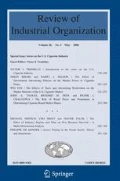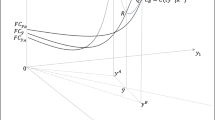Abstract
This paper uses the NPV approach to merger decisions to select variables which are expected to explain changes in the aggregate number of mergers of US manufacturing and mining firms over time. We test for and estimate a cointegrating relationship between such variables. We find that in the long run the number of mergers and acquisitions is positively related both to the level of manufacturing production and to the level of the nominal bond yield. A short run dynamic model is also presented. Annual changes in merger and acquisition activity were found to be positively related to current changes in Tobin's Q and changes in Q lagged one, two and four years; positively related to changes in the current bond yield but negatively related to changes in the yield in the previous year; and finally that changes in merger activity were related to the degree to which the number of mergers differed from the long run or equilibrium value in the previous year.
Similar content being viewed by others
References
AuerbacherA. J. (ed) (1988) Corporate Takeovers: Causes and Consequences, National Bureau of Economic Research. University of Chicago Press, Chicago.
BeckensteinA. R. (1979) ‘Merger activity and merger theories: An empirical investigation’, Antitrust Bulletin, 24, 105–128.
BenzingC. (1991) ‘The determinants of aggregate-merger activity—before and after Celler-Kefauver’, Review of Industrial Organisation, 6, 61–72.
BrittlingmayerG. (1985) ‘Did antitrust policy cause the great merger wave?’, Journal of Law and Economics, 28, 77–111.
ChowdhuryA. R. (1993) ‘Univariate time-series behaviour of merger activity and its various components in the United States’, Applied Financial Economics, 3, 61–66.
ClarkJ. J., ChakrabartiA. K., and ChiangT. C. (1988) ‘Trend and stochastic movements in U.S. merger activity’, Review of Economics and Business, 28, 6–19.
Clark, J. J., Chakrabarti, A. K., and Chiang, T. C. (1988) ‘Stock prices and merger movements: Interactive relations’, Weltwirschaftliches Archiv, 287–300.
CookeT. E. (1988) International Mergers and Acquisitions, Basil Blackwell, Oxford.
CrookJ. N. (1995) ‘Time series explanations of merger activity: Some econometric results’, International Review of Applied Economics, 9, 59–85.
CuthbertsonK., HallS. G. and TaylorM. P. (1992) Applied Econometric Techniques, Philip Allan, London.
DickeyD. A. and FullerW.A. (1979) ‘Distribution of the estimators for autoregressive time series with a unit root’, Journal of the American Statistical Association, 74, 427–431.
DickeyD. A. and FullerW. A. (1981) ‘Likelihood ratio statistics for autoregressive time series with a unit root’, Econometrica, 4, 1057–1072.
EngleR. F. and GrangerC. W. J. (1987) ‘Co-integration and error correction: Representation, estimation, and testing’, Econometrica, 55, 251–276.
FullerW. A. (1976) Introduction to Statistical Time Series, Wiley, New York.
GodfreyL. G. (1978a) ‘Testing against general autoregressive and moving average error models when the regressors include lagged dependent variables’, Econometrica, 46, 1293–1302.
GodfreyL. G. (1978b) ‘Testing for higher order serial serial correlation in regression equations when the regressors contain lagged dependent variables’, Econometrica, 46, 1303–1310.
GolbeD. L. and WhiteL. (1988) ‘Mergers and acquisitions in the U.S. economy’, in A. J.Auerbacher AuerbacherA. J. (ed.) Corporate Takeovers: Causes and Consequences, National Bureau of Economic Research. University of Chicago Press, Chicago.
GordonM. J. (1962) The Investment, Financing and Valuation of the Corporation, Irwin, Boston.
GortM. (1969) ‘An economic disturbance theory of mergers’, Quarterly Journal of Economics, 83, 624–642.
JacqueminA. P. and deJongH. W. (1974) Markets, Corporate Behaviour and the State, Nijhoff, The Hague.
JarqueC. M. and BeraA. K. (1980) ‘Efficient tests for normality, homoscedasticity and serial independence of regression residuals’, Economic Letters, 6, 255–259.
JohansenS. (1988) ‘Statistical analysis of cointegration vectors’, Journal of Economic Dynamics and Control, 12, 231–254.
JohansenS. and JuseliusK. (1990) ‘Maximum likelihood estimation and inference on cointegration — with applications to the demand for money’, Oxford Bulletin of Economics and Statistics, 52, 169–210.
deJongH. W. (1974) ‘Theory and evidence concerning mergers: An international comparison’, in A. P.Jacquemin and H. W.deJong (eds), Markets, Corporate Behaviour and the State, Nijhoff, The Hague.
MacKinnon, J. G. (1990) ‘Critical values for cointegration tests’, UC San Diego Discussion Paper 90–4.
MelicherR. W., LedoterJ., and D'AntonioL. (1983) ‘A time series analysis of aggregate merger activity’, The Review of Economics and Statistics, 65, 423–430.
MuellerD. C. (1969) ‘A theory of conglomerate mergers’, Quarterly Journal of Economics, 84, 643–659.
MuscatelliV. A. and HurnS. (1992) ‘Cointegration and dynamic time series models’, Journal of Economic Surveys, 6, 1–43.
NelsonR. L. (1959) Merger Movements in American Industry 1895–1956, National Bureau of Economic Research. University Press, Princeton.
OsborneD. R., ChuiA. P. L., SmithJ. P. and BirchenhallC.R. (1988) ‘Seasonality and the order of integration for consumption’, Oxford Bulletin of Economics and Statistics, 50, 361–377.
PhillipsP. C. B. and PerronP. (1988) ‘Testing for a unit root in time series regression’, Biometrica, 75, 335–346.
PolonchekJ. A. and SushkaM. E. (1987) ‘The impact of financial and economic conditions on aggregate merger activity’, Managerial and Decision Economics, 8, 113–119.
ShughartW. F. and TollisonR. D. (1984) ‘The random character of merger activity’, Rand Journal of Economics, 15, 500–509.
Steiner, P. (1975) Mergers: Motives, Effects, Policies, University of Michigan Press.
Tobin, J. and Brainard, W. C. (1977) ‘Asset markets and the cost of capital’, in Ballassa and Nelson (eds.), Economic Progress, Private Values and Public Policy, 235–262.
TownR. J. (1992) ‘Merger waves and the structure of merger and acquisition time-series’, Journal of Applied Econometrics, 7, S83-S100.
Weston, J. F. (1961) The Role of Mergers in the Growth of Large Firms, University of California Press.
YuleG. U. (1926) ‘Why do we sometimes get nonsense-correlations between time series? A study in sampling and the nature of time series’, Journal of the Royal Statistical Society, 89, 1–64.
Author information
Authors and Affiliations
Additional information
Much of this work was carried out whilst I was a Visiting Scholar at The McIntire School of Commerce, University of Virginia, during the Spring of 1994. I would like to thank The McIntire School for providing such a stimulating environment and in particular I would like to thank Larry Pettit, George Overstreet, Bob Webb, Mark White, Bob Kemp and an anonymous referee for helpful suggestions. I alone am responsible for all errors and omissions. I would like to thank The Carnegie Trust for The Universities of Scotland for funding this research.
Rights and permissions
About this article
Cite this article
Crook, J. Short and long run movements in U.S. merger activity. Review of Industrial Organization 11, 307–323 (1996). https://doi.org/10.1007/BF00414401
Issue Date:
DOI: https://doi.org/10.1007/BF00414401




